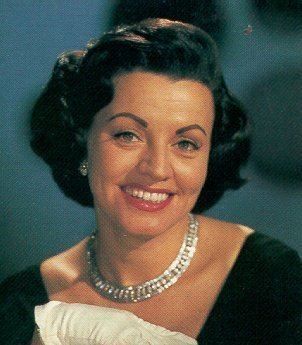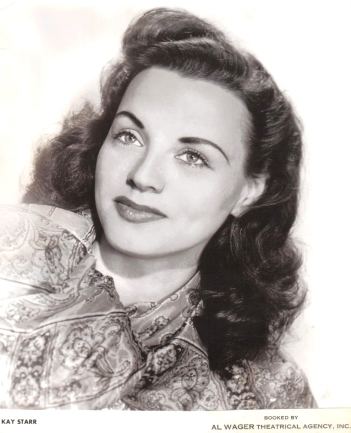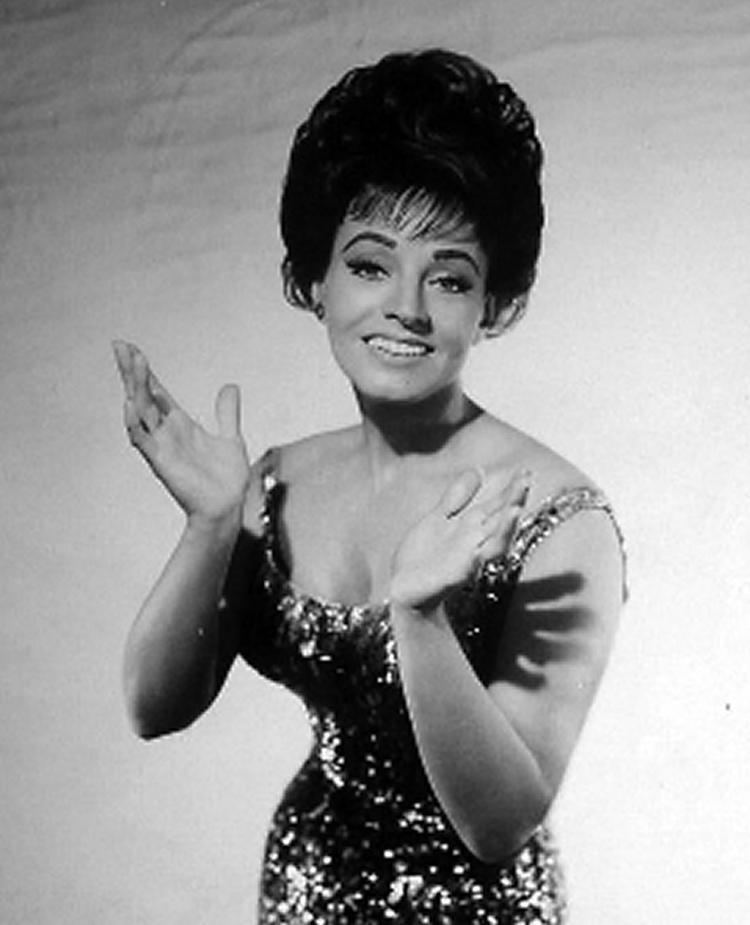Genres Traditional pop, jazz Website Official website Albums Rockin' With Kay Labels Capitol, RCA Victor Spouse Vic Schoen (m. 1953–2000) | Years active 1939–present Role Singer Occupation(s) Singer Name Kay Starr Movies The Pied Piper of Hamelin | |
 | ||
Birth name Katherine Laverne Starks Born July 21, 1922 (age 103)
Dougherty, Oklahoma ( 1922-07-21 ) Parents Annie Starks, Harry Starks Similar People Jo Stafford, Tennessee Ernie Ford, Teresa Brewer, Frankie Laine, Johnnie Ray | ||
World premiere of rising starr kay starr a life in song promo
Katherine Laverne Starks (July 21, 1922 – November 3, 2016), known as Kay Starr, was an American entertainer, pop and jazz singer who enjoyed considerable success in the 1940s and 1950s. She is best remembered for introducing two songs that became #1 hits in the 1950s, "Wheel of Fortune" and "The Rock And Roll Waltz".
Contents
- World premiere of rising starr kay starr a life in song promo
- Kay Starr Rock And Roll Waltz 1954
- Life and career
- Television
- Personal life
- Albums
- Singles
- References

Starr was successful in every field of music she tried: jazz, pop and country. But her roots were in jazz. Billie Holiday, considered by many the greatest jazz singer of all time, called Starr "the only white woman who could sing the blues."

Kay Starr - Rock And Roll Waltz ( 1954 )
Life and career

Kay Starr was born Katherine Laverne Starks on a reservation in Dougherty, Oklahoma. Her father, Harry, was a full-blooded Iroquois native American; her mother, Annie, was of mixed Irish and Native American heritage. When her father got a job installing water sprinkler systems for the Automatic Sprinkler Company, the family moved to Dallas. There, her mother raised chickens, whom Kay serenaded in the coop. Kay's aunt Nora was impressed by her 7-year-old niece's singing and arranged for her to sing on a Dallas radio station, WRR. First she took a talent competition by storm, finishing 3rd one week and placing first every week thereafter. Eventually she had her own 15-minute show. She sang pop and "hillbilly" songs with a piano accompaniment. By age 10 she was making $3 a night, which was quite a salary during the Great Depression.

When Starr's father changed jobs, the family moved to Memphis, where she continued performing on the radio. She sang "Western swing music," still mostly a mix of country and pop. During this time at Memphis radio station WMPS, misspellings in her fan mail inspired her and her parents to change her name to "Kay Starr".

At 15, she was chosen to sing with the Joe Venuti orchestra. Venuti had a contract to play in the Peabody Hotel in Memphis which called for his band to feature a girl singer, a performer he did not have at the time. Venuti's road manager heard Starr on the radio and recommended her to his boss although she was still in junior high school and her parents insisted on a midnight curfew.
Though she had brief stints in 1939 with Bob Crosby and Glenn Miller (who hired her in July of that year when his regular singer, Marion Hutton, was sick), Starr spent most of the next few years with Venuti until he dissolved his band in 1942. It was, however, with Miller that she cut her first two recordings: "Baby Me" and "Love with a Capital You". They were not a great success, in part because the band played in a key that, while appropriate for Marion Hutton, did not suit Kay's vocal range.
After finishing high school, she moved to Los Angeles and signed with Wingy Manone's band; then from 1943 to 1945 she sang with Charlie Barnet's ensemble, retiring for a year after contracting pneumonia and later developing nodes on her vocal cords as a result of fatigue and overwork.
In 1946 Starr became a soloist, and in 1947 signed a contract with Capitol Records. The label had a number of female singers signed up including Peggy Lee, Ella Mae Morse, Jo Stafford and Margaret Whiting, so it was hard to find her a niche of her own. In 1948 when the American Federation of Musicians was threatening a strike, Capitol wanted to have each of its singers record a back list for future release. Being junior to all these other artists meant that every song Starr wanted to sing was taken by her rivals on the label, leaving her a list of old songs which nobody else wanted to record.
Around 1950 Starr made a trip back home to Dougherty and heard a fiddle recording of Pee Wee King's song, "Bonaparte's Retreat". She liked it so much that she wanted to record it, and contacted Roy Acuff's publishing house in Nashville, and spoke to Acuff directly. He was happy to let her record it, but it took a while for her to make clear that she was a singer, not a fiddler, and therefore needed to have some lyrics written. Eventually Acuff came up with a new lyric, and "Bonaparte's Retreat" became her biggest hit up to that point, with close to a million sales.
In 1955, she signed with RCA Victor Records. However, at this time, rock-and-roll was displacing the existing forms of pop music and Kay had only two hits, the aforementioned, which is sometimes considered her attempt to sing rock and roll, and sometimes as a song poking fun at it, "The Rock And Roll Waltz". She stayed at RCA Victor until 1959, hitting the top ten only once more with "My Heart Reminds Me", then returned to Capitol.
Most of Starr's songs had jazz influences, and, like those of Frankie Laine and Johnnie Ray, were sung in a style that anticipated the rock and roll songs that followed. These included her smash hits "Wheel of Fortune" (her biggest hit, number one for 10 weeks), "Side by Side", "The Man Upstairs", and "Rock and Roll Waltz". One of her biggest hits was her version of "(Everybody's Waitin' For) The Man with the Bag", a Christmas song that quickly became a holiday favorite. The song has remained popular over the years and has been covered by many artists, including Vonda Shepard, who performed the song on an Ally McBeal episode of the same name.
Television
After rock-and-roll swept older performers from the charts, Starr subsequently appeared in such television series as NBC's Club Oasis, mostly associated with the bandleader Spike Jones. However, Starr recorded several albums, including Movin’ (1959), an up-tempo jazz album. Others included Losers, Weepers… (1960) and I Cry By Night (1962) in the jazz/blues genre, as well as a country album entitled Just Plain Country (1962).
After departing from Capitol Records for a second time in 1966, Starr continued touring concert venues in the US and the UK. She also recorded several jazz and country albums on small independent labels, including a 1968 album with Count Basie, How About This and Back to the Roots (1975). In the late 1980s she was featured in the revue 3 Girls with Helen O'Connell and Margaret Whiting, and in 1993 she toured the United Kingdom as part of Pat Boone’s April Love Tour. Her first "live" album, Live At Freddy's, was released in 1997. Kay Starr performs "Blue and Sentimental" with Tony Bennett on his 2001 album Playin' with My Friends: Bennett Sings the Blues.
. In 2006 a remix by Stuhr of Starr's vocal of the classic "I've Got My Love to Keep Me Warm" was used in a commercial for Telus. Additionally, a remixed version of "It's a Good Day" was used in a 2014 commercial spot for HomeGoods.
Personal life
As of 2007 she resided in the Bel Air neighborhood of Los Angeles; married six times, she had a daughter and a grandson.
Starr died on November 3, 2016 at her home in Bel Air from complications of Alzheimer's disease at the age of 94. Her funeral arrangements were handled by Pierce Brothers in Los Angeles, CA, and she was interred at Dougherty Cemetery, Dougherty, OK, Section L, with her parents.
